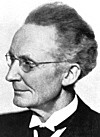
The Section on Oceans and Atmosphere has established a new medal for distinguished
research in atmospheric sciences. The medal is named after Vilhelm Bjerknes
(1862-1951), one of the leading atmospheric scientists of the first half of this century.
In the following there is a summary provided by Arnt Eliassen, Honorary Member of
the EGS:
Vilhelm Bjerknes began his scientific career as a theoretical physicist. In the
1890's, when he was professor of mechanics and mathematical physics in Stockholm, he
became aware that the classical hydrodynamic theory for inviscid fluids, culminating in
Helmholtz' and Kelvin's vortex conservation theorems, is based on a restricted fluid model
where the density distribution is necessarily barotropic. In the real world,
however, the fluid density will depend not only on pressure, but on temperature and
composition as well, and baroclinic density distributions may occur and lead to formation
or destruction of circulatory motions. To treat such more general fluids, the
hydrodynamic equations must be combined with the equations of thermodynamics. With
the introduction of this generalized fluid dynamics which he termed "physical
hydrodynan-tics", Bjerknes had laid the theoretical foundation for the study of
motions in the atmosphere and the oceans with their baroclinic density distributions.
In a programmatic paper from 1904 he proposed the procedure Which is now called numerical
weather prediction. He advocated that weather prognosis should be considered as an
initial value problem of mathematical physics, and carried out by integrating the
governing equations forward in time, starting from the observed atmospheric state.
This was of course not feasible at that time. Nevertheless, Bjerknes considered this
as the principle objective of meteorological research, trusting that adequate observations
and computer facilities would emerge in the future. With financial support from the
Camegie Institution of Washington, he embarked on a major research project
ain-ting at
clarifying the many partial problems encountered, first of all the techniques of
diagnosis. The first results were published in the impressive work "Dynamic
Meteorology and Hydrography" from 1910-191 1, with three research assistants, Johan
W. Sandström from Sweden, and the Norwegian students Olaf D. Devik and Th.
Hesselberg as co-authors. It contains a wealth of proposed improvements and
new techniques in weather analysis. Thus geopotential is recommended as vertical
coordinate instead of geometrical height, and the bar (or mb) instead of mm or inches of
Mercury. Analysis of absolute and relative topography of isobaric surfaces is
introduced and illustrated by analyzed maps from 1000 mb up to 300 mb. The wind
field at the ground level is represented by isotachs, streamlines and isogones.
Confluence lines were identified, apparently representing the germ of the frontal
concept, and from the continuity equation it was found that the vertical mass flux over
these lines is predominantly upward.
The problems of analysis were further studied during Bjerknes's stay in Oslo and Leipzig.
In 1917 Bjerknes settled in Bergen with two research assistants, his son Jack and
Jack's fellow student Halvor Solberg; they were later joined by the Swedish meteorologist
Tor Bergeron. This team put forward the polar front theory of cyclones, which has
for 75 years served as an effective tool in weather analysis and forecasting.
Vilhelm Bjerknes had a rare ability to attract and inspire gifted students. He
promoted progress in his field not only through his own work, but also by recruiting into
geophysics a considerable number of students who later became prominent meteorologists or
oceanographers. He was also efficient in making his and his co-worker's achievements
known, not only to the scientific community, but to politicians and the public as well.